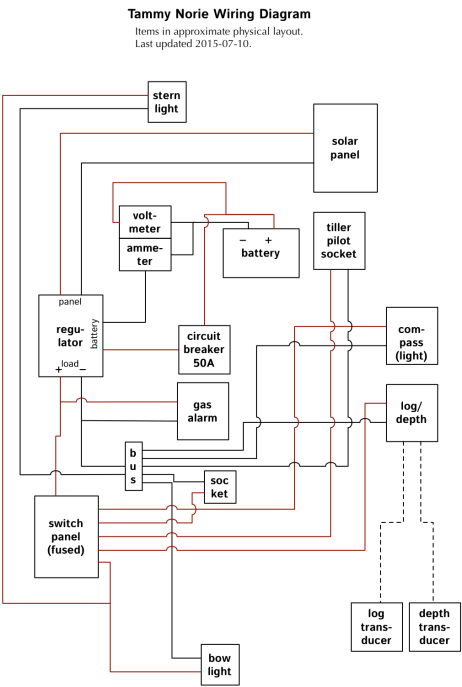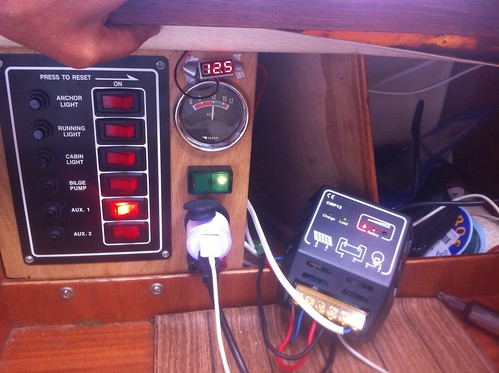I’ve made this diagram (which is also on the “About” menu of this blog) in case anyone’s interested.
I’ll try to keep it up to date if anything changes. The only addition I’m expecting this year is a fixed VHF radio, probably a Standard Horizon GX2200 because it has built-in GPS and AIS, and so can provide me with a ship proximity alarm without any further equipment.
Here’s a slightly out-of-date picture of where the switch panel and most of the connections are located, under the bridge deck. The main difference now is that I have an integrated digital volt/ammeter that is much more responsive.



Interesting – I haven’t got as far as a solar panel (have to sort the osmosis first!) but I have done the wiring bar the log and sounder; also added a usb / lighter socket which wasn’t hard and put a small led lamp in the top of the 1/4 berth, just because it makes the whole interior look larger.
PS – have you had any issues with your log/sounder display affecting the compass? NASA told me that “30cm is more than enough” between the two, but I’d rather not drill holes before being sure!
PPS – bow bicolour lead – noticed you said you had water coming down the cable. I found that the same problem (over many years exposed to the elements) had rotted away the anchor locker bulkhead and I had to replace it, which is a nasty job. The wire had been led between the wood and the grp……..
I have not noticed any effect from the display on the compass, but I haven’t calibrated the compass since I fitted it. I should swing the compass with it on and off to make sure. Mine are about 150mm apart.
My bow light cable came down through the starboard aft pulpit foot and into the cabin about 20mm away from the anchor bulkhead. It was dripping on to the shelving, but not for long enough to rot anything. Tammy Norie was stored dry for so long that she’s suffered very few long term problems. It’s all sealed tight now.
The small box labelled “socket” is a lighter socket. At the moment there’s an adapter from that to a double lighter socket and double USB. Usually the iPhone hangs off that, recording my GPS track, and not much else. The utility light goes in it when I’m anchored or steaming at night. I charge up my video camera, handheld VHF, spotlight, etc. from it as well when they need it. Lighter sockets are a really dumb bit of technology that we’ve ended up with by accident!
If you want to wait a couple of weeks I’ll be back on board and will swing the compass. I ought to do it anyway. Then I can warn you about any problems with my setup.
Great wiring diagram. Does your battery still life in the aft cockpit locker. I was thinking of getting a Rebbel cell battery (http://www.rebel-cell.com/inet/rebelcell/site.nsf/vimgfiles/CLIC-9G2TGF/$file/Informationbrochure%20Rebelcell%20Marine%20UK%20small%2005022014.pdf) and store it just forward of the mast.
Navigation lights will of this make http://www.lopolight.com/products/productdetails.aspx?item=100-009 which eliminates a lot of wiring. Basically two wires up the mast.
Still pondering the cabin lights as I am getting blinder as the year progress. I will definitely go with LED of ≈ 2600 kelvin to keep things comfortable but with fairly high lumen output. Also ooking at brands that can switch to red light for nighttime operations. These would do the trick but I doubt whether they would be very enjoyable atmosphirically: http://www.lopolight.com/products/Installation%20instructions/400-122%20package%20letter.pdf
My main goal now is to step the mast this coming sunday and hoist the sail.
All these other considerations are secondary!!!!
My battery is at the aft end of the locker beneath the cockpit (where the engine would be). I also wanted to fit it forward of the mast, but it was just a bit too big. I do think it’s a good location, as it’ll help to move weight forward. So if you can fit a battery there, go for it!
I considered masthead lights, but have decided against. I read a couple of accounts from ship captains who said that masthead tricolour lights are hard to see, and LED masthead lights are worse. The main reason for a tricolour is to reduce power consumption by sharing a single incandescent bulb, but with LEDs this isn’t really an issue. These two factors made me stick with the deck-level bicolour and stern lights that I started with. They actually have incandescent bulbs in at the moment, but I’ll replace them with LED bulbs in future. I might replace the whole thing with sealed LED units if compatible ones appear. When motoring, I show a single all-round white.
I use a utility light as a cabin light, and have a few cheap battery-powered LED lights around. Better interior lighting is a fairly low priority for me.
Best of luck with the mast and sail! With a bit of luck, I will be on my way towards the Netherlands on Sunday.
About the lighter sockets – a dumb bit of technogoly indeed but what would be a better alternative?
I feel the same way about lighter sockets. They’re a case of the “worse is better” principle. I’ll put up with them, but I won’t like them!
Here is another nice addition: openpilot
Check:
https://www.startpage.com/eng/advanced-search.html?cat=web&query=openplotter&#hmb
Direct link: http://www.sailoog.com/openplotter
Thanks that looks interesting. I have several Raspberry Pis and an ESP32 (ultra low power thing with sensors) waiting for my attention, and this might be part of the fun.
My goal, however, is never to make any electronic equipment part of the essential running of Tammy Norie. That will keep my skills tuned up.
The main problem with the Raspberry Pi is that it draws 100mA. The Pi Zero is a bit better but still an energy hog. They aren’t designed as low-power devices. That’s why I started looking at the ESP32 to run sensors, GPS, etc.
It’s nice to have a plotter sometimes. I’m thinking about these good-value chart sets with Android software. http://www.visitmyharbour.com/download-android-charts/
Indepence of electrickery – good point!
Love the tinkering though!
This solution lks promising however.
Last year I used OpenCPN and local data gathered by http://www.wadvaarders.nl and a paper map for navigating.
Being as blind as a bat at night and loosing all sense of direction in the dark, a chartplotter is a useful thing for me – especially at night.
What type of tablet works for you on Tammy?
I don’t have a tablet or laptop aboard. I sometimes use my phone to record GPS tracks for later. I don’t use electronic navigation in general.